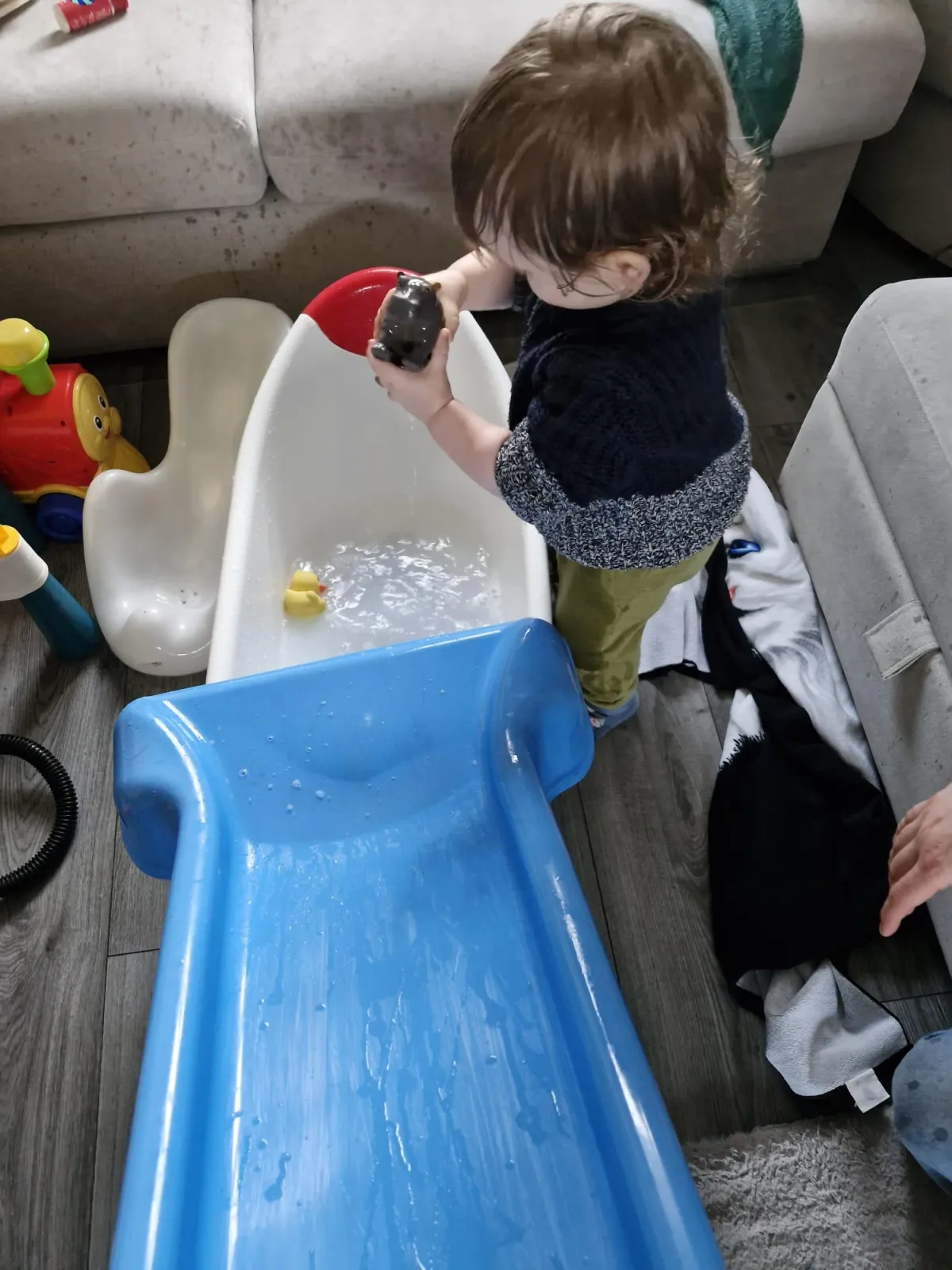🎓 New: Get free revision tips + discounts via WhatsApp – Join Here

5 Ways to Bring Classic Novels to Life: Engaging KS3 & GCSE Students with Interactive Learning
📚✨ Bringing a Story to Life = Deeper Understanding ✨📚
How can we encourage our children, our students, to explore classics work in a fresh way in order to encourage:
Critical thinking
Personal engagement
Deeper understanding
As a mum and educator, I was thinking about this as I took Jamie French’s Noisy Bathtime to a whole new level with water play—and it wasn’t just fun, it was educational! My toddler loved re-enacting the story. I could see him anticipating the next line so he could bring it to life. What was particularly interesting was when I asked him, "What would you add next?" - he thought about it! He wanted his slide to make a 'water slide' for the hippo to slide down! I was amazed by his creativity.
And this got me thinking...
Whether it’s exploring characters or deepening comprehension, bringing a novel to life offers so many learning benefits for KS3 & GCSE English students. Here’s why you should take your book experience beyond the pages and into the real world!
5 Reasons Why Bringing a Novel to Life is Vital:
Enhances Understanding – Physical engagement with the story solidifies themes and character motivations. According to cognitive scientist Dr. John Medina, incorporating physical activities like role-play or simulations helps our brains retain information for longer by activating multiple brain regions, which aids memory retention. (Brain Rules, 2008)
Boosts Engagement – Active participation in the story through play or alternate media keeps students engaged. Professor Mihaly Csikszentmihalyi, in his book Flow, argues that immersion in an activity (such as acting out a scene) heightens concentration and enjoyment, leading to deeper learning.
Improves Comprehension – Re-enacting scenes or creating visual connections like drawings or models helps students make abstract ideas tangible. As Dr. Richard Mayer, a leading cognitive scientist, says in The Cambridge Handbook of Multimedia Learning (2014), combining text and visual stimuli aids comprehension and understanding.
Aids Memory – Creating real-world connections makes the story easier to remember. Studies show that students retain 80% of what they do, but only 20% of what they read. (National Training Laboratories)
Encourages Critical Thinking – Engaging physically and intellectually with the text forces students to analyse characters’ choices. Bloom’s Taxonomy (1956) highlights that analysing and creating (such as developing alternate endings or re-imagining a character) are higher levels of learning that promote deeper understanding.
Sounds great, but you might be thinking:
How can we bring novesl to life? 🤔
Here are 5 ways:
5 Ways to Bring a Novel to Life:
Interactive Play – Re-enact scenes or scenarios from the story using simple props. For example:
To Kill a Mockingbird: Re-enact the trial scene between Atticus Finch and the prosecutor.
A Christmas Carol: Re-enact the Ghost of Christmas Present’s visit to Scrooge.
Expert Insight: According to Dr. Robert Bjork, a professor of psychology at UCLA, retrieval practice (like role-playing) helps students "activate" memory pathways, making it easier to recall key moments in the story.
Art & Craft – Draw characters, settings, or create storyboards to visualise events.
For Lord of the Flies, students could create a “desert island map” or draw Ralph, Piggy, and Jack to understand the power dynamics.
For Dr. Jekyll and Mr. Hyde, students could sketch the contrasting characters of Dr. Jekyll and Mr. Hyde to explore duality.
Software Help: Use Canva or Storybird to create digital illustrations or timelines of key events.
Role Play – If you don’t want to physically re-enact scenes, create characters through games. Use The Sims or Minecraft to build settings, interact as characters, or create alternate scenes. These gaming tools make character and scene exploration fun, and can replicate a role-play environment in a digital world.
For Dr. Jekyll and Mr. Hyde, you could build two contrasting homes in Minecraft representing the two personalities.
Gamification – If role-playing isn’t your thing, use gamification to create an interactive experience. Assign "quests" or "missions" based on scenes from the novel.
For A Christmas Carol, students could complete challenges as Scrooge, such as finding “the spirit of generosity” in real-life actions.
Software Help: Use tools like Kahoot or Quizlet to create quizzes or flashcards about characters, events, or quotes to make the experience more engaging. Create a competition or challenge to see who can recall more from the text.
Write Alternate Endings – Encourage students to reimagine a novel’s conclusion and reflect on the story's themes. This critical exercise helps students develop their own viewpoints and connect to the material.
Lord of the Flies: What if Ralph had joined Jack’s tribe? What would that mean for civilisation vs. savagery?
To Kill a Mockingbird: What if Atticus Finch had lost the trial? How would the town have reacted?
Expert Insight: Dr. Daniel Willingham, in Why Don’t Students Like School? (2009), emphasises the value of creating and problem-solving because these skills encourage deeper processing of information and stimulate long-term retention.
Example of an Alternate Ending – To Kill a Mockingbird:
Alternate Ending:
In this alternate ending, Tom Robinson is convicted as in the original novel, but the aftermath takes a darker turn. Instead of Atticus's quiet resilience and Maycomb returning to its usual ways, tensions escalate. The town becomes more divided than ever, with open confrontations between those who supported Atticus and those entrenched in prejudice. Scout, who had once viewed Maycomb with childhood innocence, now sees it for what it truly is—a place where justice is fragile, and fairness is not guaranteed.
Jem, deeply shaken by the trial's outcome, refuses to accept the town’s complacency. Unlike in the original novel, where his outrage is internalised, here he takes action, attempting to rally support for change. However, Atticus, despite his unwavering moral compass, warns his children that change is slow and dangerous in a town like Maycomb. This version of the story sees the Finch family facing not just disillusionment but active hostility from some townsfolk who resent Atticus’s challenge to the status quo.
This alternate ending deepens the novel’s critique of racial injustice by removing any sense of closure. Rather than Maycomb slipping back into its old ways, it shows how even small acts of defiance can ignite change—though not without cost. Scout’s coming-of-age is marked not just by understanding injustice but by realising that standing against it can lead to real consequences.
How Writing Alternate Endings Helps Integrate Different Interpretations:
Writing alternate endings encourages students to engage critically with a novel’s themes and characters. By imagining a different resolution, they must consider how small changes in the plot can significantly affect the novel’s message.
In To Kill a Mockingbird, an alternate ending where Tom Robinson’s conviction leads to further unrest forces students to rethink the impact of the trial. Would the town rally behind Atticus, or would he face greater ostracisation? Would Jem become an activist, or would he become disillusioned and withdraw? By exploring these possibilities, students gain a deeper understanding of the novel’s exploration of morality, justice, and social change.
This activity also allows for multiple interpretations to coexist. Some students may write endings that provide hope, where Maycomb begins to change, while others might emphasise the harsh reality of systemic injustice. Both interpretations are valid and reflect different readings of the novel’s themes.
Additionally, rewriting an ending can be particularly useful in classroom discussions, as it encourages debate. Should Harper Lee’s original ending be seen as realistic, or was it too neat? How does an alternate ending change the reader’s perception of the characters? This approach fosters analytical thinking, helping students develop their ability to form and support their own interpretations—an essential skill for GCSE and A-Level English.
By engaging in this creative process, students move beyond passive reading and take an active role in exploring literature, ultimately gaining a richer, more personal connection to the text.
Taking It Further: Using Alternate Endings for Creative Writing
Exploring alternate endings isn’t just an analytical exercise—it’s a fantastic way to develop creative writing skills! By re-imagining a novel’s conclusion, students engage in world-building, character development, and thematic exploration, all of which enhance their ability to craft compelling narratives.
Here’s how you can take this further:
1. Expand the Alternate Ending into a Full Short Story
Rather than just tweaking the final scene, challenge students to write a full short story that explores the consequences of their alternate ending. For example:
To Kill a Mockingbird: If Maycomb’s racial tensions escalated after the trial, how would Atticus and his family cope? Would Jem take a stand and face backlash?
Lord of the Flies: What if Ralph had joined Jack’s tribe instead of resisting? How would his morals change?
Creative Writing Tip: Encourage students to develop subplots. For example, introduce a new character (perhaps another townsperson in To Kill a Mockingbird) to provide a fresh perspective on the events.
2. Rewrite a Scene from Another Character’s Perspective
Writing from an alternative point of view helps develop narrative voice and empathy.
Dr Jekyll and Mr Hyde: What if Hyde had written a diary entry reflecting on his transformation?
A Christmas Carol: What if we saw Scrooge’s redemption through the eyes of Bob Cratchit?
Creative Writing Tip: Encourage students to use distinctive voices. Hyde’s writing, for example, might be frantic and disjointed, while Bob Cratchit’s might be hopeful yet weary.
3. Create a “What Happens Next?” Sequel Scene
Instead of simply altering the ending, students can extend the novel with a sequel scene or epilogue.
To Kill a Mockingbird: Years later, Scout looks back on the trial—has Maycomb changed, or does injustice still prevail?
Lord of the Flies: The boys are rescued, but how do they adjust to normal society after what they’ve done?
Creative Writing Tip: Encourage students to consider character development. Would Ralph suffer from trauma? Would Jack struggle with power loss?
4. Use Gamification or AI Tools to Generate Story Ideas
For students who struggle with starting a story, interactive tools can help generate ideas:
AI Story Generators: Tools like Sudowrite can provide alternate plot twists.
Gamification Apps: Tools like Twine (for interactive storytelling) allow students to create branching narratives, letting them explore multiple endings in a choose-your-own-adventure format.
Why This Helps Improve Writing Skills
✔ Encourages Critical Thinking – Students must consider how small changes can alter the story’s themes.
✔ Enhances Creativity – Imagining new possibilities develops original thinking.
✔ Develops Narrative Structure – Expanding a story teaches pacing, conflict, and resolution.
✔ Strengthens Analytical Skills – Writing creatively forces students to engage deeply with a text.
Takeaways:
Immersing students in the text through creative, interactive experiences isn’t just fun—it’s a proven method to enhance understanding, boost engagement, and improve memory retention. Whether you’re re-enacting scenes, creating digital worlds, or writing new endings, the more engaged you are with a text, the more you’ll get out of it.
©2025 Uplevel Academy

